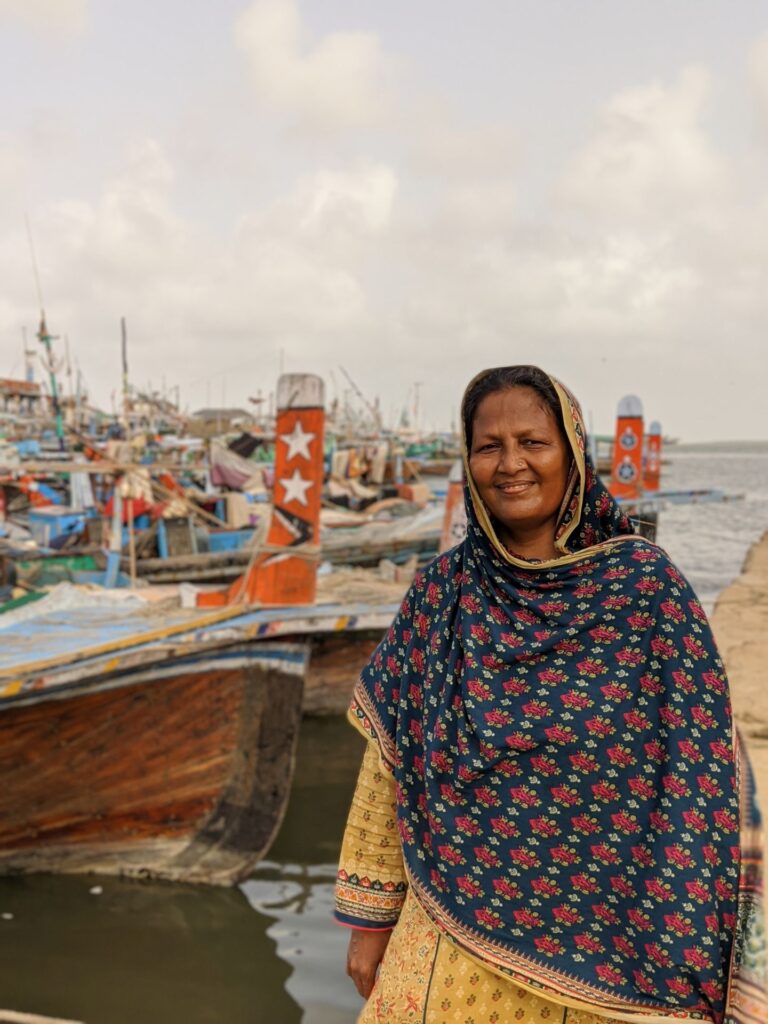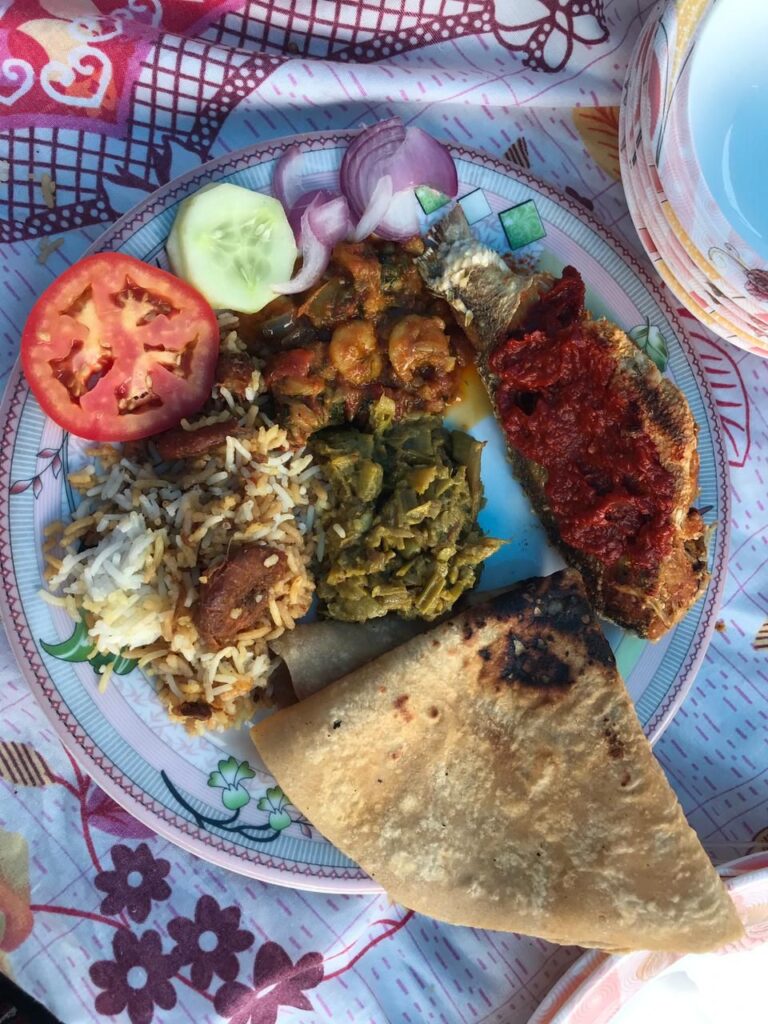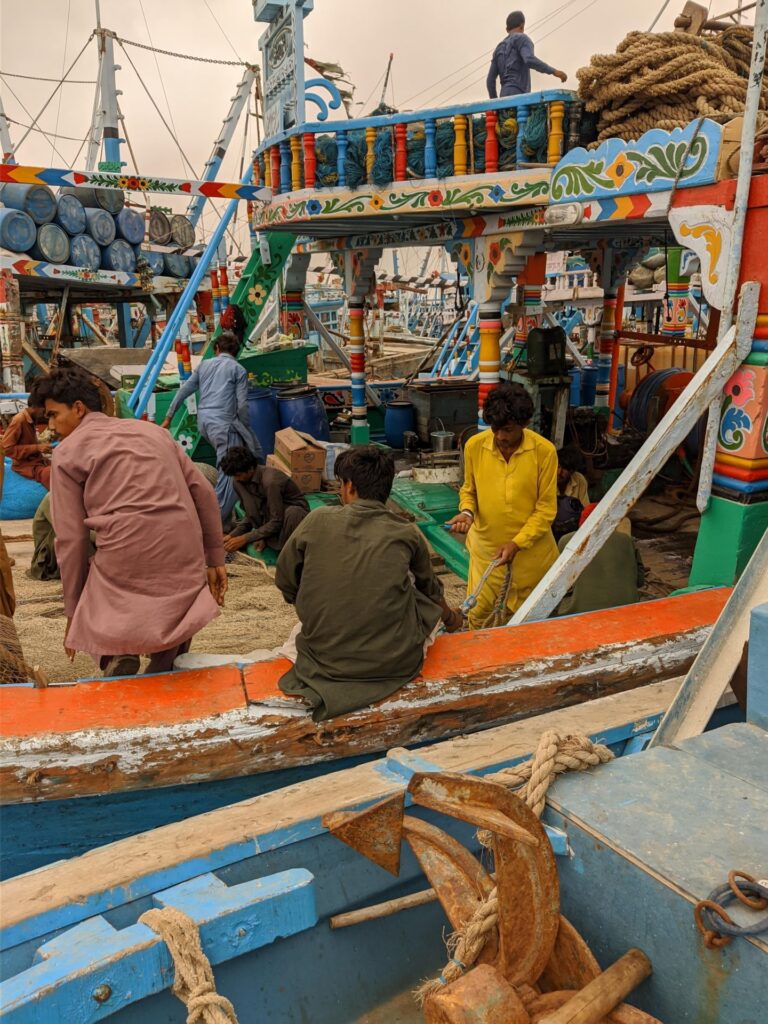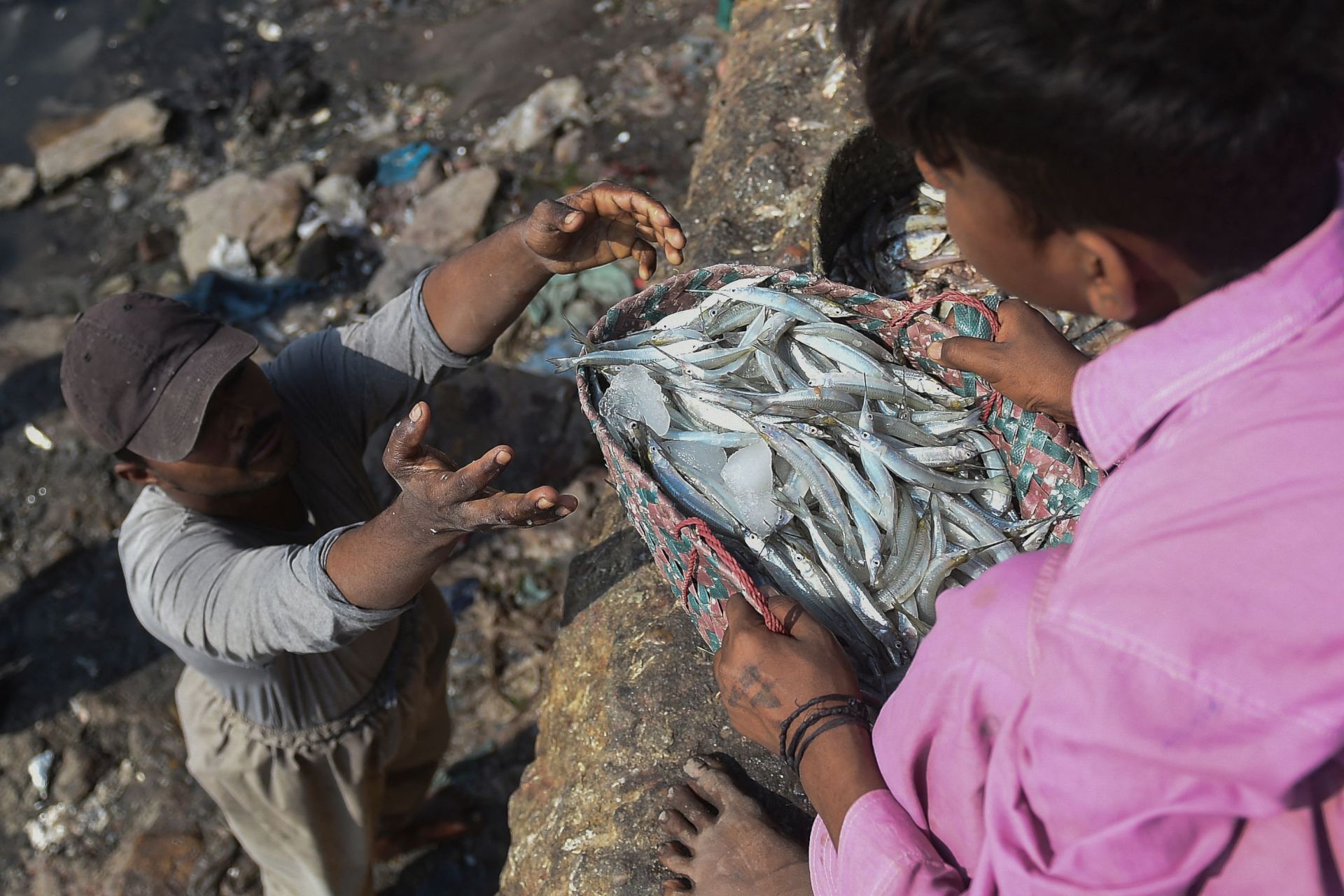A decade ago, in a conversation about cricket, the veteran Pakistani journalist Imran Aslam made an offhand remark about the city of Karachi. “[It is] a city by the sea [that] has no sea culture, because the entire population here is either ‘Ganga Jamni’ [from the Gangetic Plains of northern India] or from the mountains. … Nobody really eats seafood, and you don’t see any sailors.” This observation stayed with me for years, and I wondered where the sea was in Karachi’s culture.
Karachi’s popular culture has been centered on its food, which carries an incredible fusion of flavors from across the subcontinent, as it hosts a diverse range of ethnicities, languages and cultures, especially compared with other parts of Pakistan. Its street food culture reflects the history of migration to the city. The flavors of Karachi’s pre-Partition migrant communities — Goans, Parsis and a host of Gujarati-speaking communities including Aga Khanis, Bohras, Memons and many others — can still be found in the inner city. But much of the city’s cuisine is dominated by the northern Indian delicacies that Partition migrants brought with them.
In the past few decades, the city’s large Pashtun population has also made it a hub for some of the best karahi and chapli kebabs in the world. (Karahi is a popular meat and tomato stir-fried stew, and chapli kebabs are herbed and fried meat patties.) Along with this, French-style boulangeries and eateries serving wood-fired pizzas cater to the city’s sizable elite population. But there isn’t a single place in the city that serves the coastal cuisine native to the region. It can only be found in the homes of the fisherfolk community, part of the Sindhi- and Balochi-speaking communities, who are the original inhabitants on Karachi’s coastline.
Last January, when I met Fatima Majeed at her home in the fishing village of Ibrahim Hyderi off the coast of Karachi, she was preparing a dish called “seiyo,” a much-loved delicacy among the community of fishers. A fragrant, vermilion paste was made of dry red chili, tamarind, garlic and sliced onions, which was smeared on top of thick slices of potatoes and filets of croaker fish. It was then layered around a shallow bowl with holes in it so that it could be steamed atop mangrove branches inside a large cauldron.

A lifelong activist with the Pakistan Fisherfolk Forum (PFF), Fatima has been a tireless campaigner for the rights of her people while also working to secure social benefits and economic opportunities for the fishing community. She and her father, Majeed Motani, also maintain archives of the customs and culture of their people, as well as the wisdom of living in harmony with the ocean, the mangroves and all the creatures within them.
She spoke about how integral prawns were to the coastal cuisine and the different dishes prepared from it, including biryani, meatballs, mincemeat and curries, among others. The kebabs, locally called chilla, are made of prawns ground to a paste on a traditional grinding stone. Onions and dill are added, along with coriander, spices and salt, plus tamarind pulp, given shape using tamarind water and then fried in oil. “Whenever someone would make these, a beautiful fragrance would envelop the whole neighborhood, and then all their friends and relatives would show up asking for a taste,” she said.

The different breeds of fish available around Karachi, such as black barracuda, white and black pomfret, croaker, white sardine, flathead and others, are also prepared by the fisherfolk community in a variety of ways. A delicate dish like javelin grunter is used to make seiyo or “baphu,” a clear tangy soup made with vegetable broth, tamarind seeds and garlic. The queen fish, which has a sweet taste, is preferred for a rice dish or curry. For frying, a croaker or pomfret fish is used, and dried fish is often toasted and eaten for breakfast. Apart from the cuisine, what is less known is that the fishers use spices for nonedible purposes too, particularly in wedding decor and garlands for the bride. Whenever there is a wedding in the neighborhood, it leaves a sweet herbal scent in the neighborhood, Fatima said.
There are many social traditions, too, that celebrate seafaring life. For instance, when a new boat is about to make its maiden voyage, relatives and well-wishers garland the owner with flowers, tie “ajraks” (traditional Sindhi block-printed clothes) and colorful scarves, as well as distribute dates among one another. The boats and launches are also elaborately decorated for the Eid festival.
“There are so many TV channels these days, but I can guarantee you that none of them have ever showcased the traditional and ancient ways with which us fishers make our food [or celebrate our culture],” said Fatima, adding that it has been “deliberately kept back.”

Zahra Malkani, an artist whose practice engages with Indigenous histories and ecological knowledge in the city, explained that this absence stems from the nature of different migrations into Karachi and how the city was organized around them.
“Sindhi and Baloch culture has been pushed to the margins of the city over the course of many decades through different political processes, and through the specific way in which the city was urbanized and modernized,” she said.
In the 18th century, when merchants from Sindh established a major port and fortress in the city, it led to the arrival of migrants across the ocean, from Gujarat, the Konkan Coast and Kerala (in present-day India), as well as inhabitants of Oman, the Persian Gulf and the Horn of Africa. Later, in 1947, when India and Pakistan were created, land-based migration overwhelmed the port city. At first, millions of Partition refugees — Muslim families from north and central India escaping communal riots — flooded the city, rapidly changing its demographics. From being a Hindu-majority city in 1941 with 42% Muslims, Karachi became 96% Muslim by 1951. By this time, only 8% of the population were native Sindhi speakers; meanwhile, 51% spoke Urdu, the language of Partition migrants. Since the 1960s, economic migrants have come from southern Punjab and Khyber Pakhtunkhwa provinces, along with war refugees from across Afghanistan and western Pakistan.
Members of the All-India Muslim League, the political party that had led to the creation of Pakistan, viewed themselves as the architects of the country’s future and created a centralized state that privileged the concerns of this migrating elite. Urban planning projects initiated in the newly independent Pakistan further led to the marginalization of the fisherfolk communities. Prime land belonging to them was acquired by the state, military and real estate developers, and access to traditional fishing sites was cut off. The land for Korangi, a neighborhood established in 1959 and celebrated for its urban reconstruction efforts inspired by postwar Europe, was acquired using the Draconian, colonial-era Land Acquisition Act of 1894. Even land for the recently developed Bahria Town, an elite housing society developed by Malik Riaz, one of Pakistan’s richest individuals, was coercively purchased from Indigenous communities through police interference and violence.
Fisherfolk often come under gunfire, face arrests and the destruction of their boats around the new Lucky Electric power plant in Port Qasim area of Karachi. They also face harassment when they fish on coastlines close to the Defence Housing Authority (DHA), popular among the country’s wealthiest, which was aggressively expanded by “reclaiming” the sea and is operated by the military. DHA has choked off Karachi’s natural stormwater drainage, leaving the posh neighborhood chaotically flooded each time it rains heavily.
Meanwhile, not only is Clifton Beach, next to the DHA, dumped with raw sewage, but the military has also consistently blocked public access, despite the fact that this is the only accessible beach for the majority of people in the city. All other beaches are far away from the city center, only accessible by damaged roads and bereft of any local seafood or amenities. The most popular beach in Karachi, French Beach, has been walled off, with only those owning fabulously expensive huts adjacent to it allowed entry. A common complaint for many elite Karachiites is that the city lacks a beach culture, as seen in the West, filled with surfers, swimmers, sunbathers and the attendant entertainment and eateries to satiate beachgoers.
“Growing up, I remember hearing this refrain often … that there is no beach culture in Karachi. [But] I think that Karachi actually does have an incredibly rich and vibrant beach culture, which is full of incredible food and folklore and music and beautiful entanglements with the sea,” Malkani said. However, the reason why it’s absent in the mainstream Pakistani imagination, she said, was because the communities who had been custodians and caretakers of the sea had been “dispossessed.”
“If you look at the history of Karachi, you will see that the city was made by the fishers. This was a fishing village which was named after a fisherwoman Mai Kolachi,” said Fatima, referring to the legendary fisher recalled in various folktales and songs. Despite this, the city has seemingly forsaken its fishers, she said. “[Over time] we have seen that the cultural presence of the fisher has been imprisoned.” For instance, when the Pakistan air force base Masroor was expanded in 1967, locals lost access to a grave site dedicated to another folklore legend, Moriro, believed to be Mai Kolachi’s son. They had been visiting the site for generations.

Vast and profound changes in the economy of the sea have also had a crushing effect on the fishers. While there were no exact figures available, there is plenty of anecdotal evidence that local seafood was found in Karachi’s markets as regularly as poultry and red meat up until the 1980s. Today, few markets offer any form of seafood, and those that do often have imported produce instead of local, which is cheaper but poorer quality. On the other hand, Karachi’s produce was being exported on a daily basis to places such as Dubai and Kuwait — and later to Singapore, China and Japan — and the unsold, lower-quality produce was available in local markets. The rates being offered in markets overseas were much higher than what most people in Pakistan could afford, hence, businessmen preferred to export, explained Hussain Rupsi, whose family has been exporting fish for several decades.
As the export market expanded, the fisherfolk were reduced to the lowest-paying, labor-intensive jobs. Most fishers were already operating on a smaller scale with little access to capital, and as industrialization increased, they were unable to compete, as the factories along the port and jetties and the larger fishing launches and ships were owned by immigrant populations.
“We often say that the earnings from the ocean rarely go into our pockets,” Fatima said. “We had always seen fishing as a means of making a living. But when it became an industry, we were very rapidly marginalized, as we lacked the capital and opportunity to establish and purchase factories, stores and large mechanized launches ourselves. We were restricted to just catching the fish, but not making the huge profits made off our catch.”
Moreover, the ravenous, industrial trawlers operated by Chinese companies, coupled with unregulated use of illegal nets that kill even the tiniest baby fish, would wipe out much of the catch and lead to drastic falls in fish populations. Hence, many have been reluctantly fishing during the off-season, when many of the species are breeding. “No real fisher would ever want to go fishing during June-July because we want the sea to be able to rest and for prawns and fish to have the time to replenish their populations,” Fatima said. But with the economy in the doldrums and most struggling to survive, many fisherfolk are left with no other choice.
With prices rising and fish populations plummeting, the fishers, who used to take home a large share of fish, now end up selling everything. Only a few of them are able to eat fish regularly at home, so local consumption of seafood has drastically declined. The greatest demand in Karachi is for fish fingers, often served at weddings, which are made from the rejected, low-quality, imported fish. The majority are sold in Punjab province, where there has been a long-standing culture of eating fried fish in the winters.

In one sense, I felt I had the answer to the question Aslam had provoked in me all those years ago. It is not that Karachi does not have a sea culture, but it has been marginalized over the years. With climate change and late-stage capitalism in full gear, it may seem already too late to reverse that. But such defeatism ignores the fact that the traditions and culture of the Indigenous fishers existed long before anyone else arrived, and, despite the past seven decades or so, Karachi has always been a city by the sea.
Sign up to our mailing list to receive our stories in your inbox.



